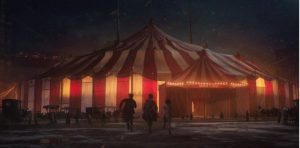Robert Olen Butler places us inside the eyes of Vachon, an artist visiting Nice to paint and sell his finished illustrations. Being both in the first-person and present tense, “Soir Bleu” keeps the reader locked in Vachon’s real-time perception of the world around him. Settling ourselves into the painter’s mind, his thoughts toward his lover, Solange, begin to show the discrepancies in his ideas of those around him. He considers himself her savior from a whore house, going so far as to tell us that she “only exists by his hand,” and that she allegedly shares the sentiment—according to him.
Sitting at an outdoor dining area, Vachon and Solange are in cahoots to secure a buyer for Vachon’s paintings in Colonel Leclerc. Across from the risque business discussion between Solange and Leclerc, a Perriot mime sits at the same table. From there, the tone shifts. Additionally, from that point on, I was completely unable to guess what came next in the best way possible. 
While we don’t hear the exact dialogue of the whole story, Vachon’s one-sided conversation with Perriot guides us through his vivid childhood memory of seeing the performer. The performance itself borders on grotesque. The Perriot character murders his unfaithful wife, playing it as a silent one-man show. It almost seems as if the performance passes down its series of events to Vachon’s father, who kills Vachon’s mother the next day. At the end of this horrific memory, Perriot—now known to be the very same performer from Vachon’s childhood—breaks the cardinal rule of mimehood: speaking. He tells Vachon to find Solange, saying he “must go to her,” in their room where Vachon had sent her.
The same twisted fate has now gripped Vachon. Solange’s affair with the Colonel is interrupted. Once Leclerc rushes out, Vachon strangles Solange, killing her. In the wake of his crime, Perriot has appeared behind him. I cannot overstate the amount of pure shock that overtook me when Perriot quite literally ripped away his grease-painted facade. I also must give an incredible amount of praise to the bombshell of what I can only assume to be some sort of specter of Vachon’s father being revealed under Perriot’s skin.
Butler presented a historical fiction to us, tying us to something in our own reality: the painting. This choice leads us to believe that his story works within the same rules we do. And yet, at the very end, Butler wrenches the story into the fantastic. Vachon’s father’s actions manifest to literally haunt him, almost forcibly making him follow in his father’s footsteps. I am inclined to believe there could have been some sort of curse involved. Vachon’s mother’s death could be explained at the time by the performance his father saw being his breaking point. Then, a pattern forms, putting the prior crime into question. Or perhaps the clown violently morphing into Vachon’s father could be some sort of crazed hallucination. We are, in fact, inside Vachon’s mind. Then again, as far as anyone is concerned, this is as real as anything else Vachon has perceived.
While I’m sure this is apparent, I found this story incredibly compelling. Especially for such a short story, where every detail must count. The cross between our reality and the sudden appearance of the fantastic is made even more momentous by the perspective and tense. We do not know what happens next, and neither does Vachon. While he is objectively a bad person, we can still feel his terror. The end rings like the sound left after a gunshot, leaving me reeling. The free reign Butler has given our imagination is thrilling. I, for one, have never been happier to be filled with so many questions at the end of a story.